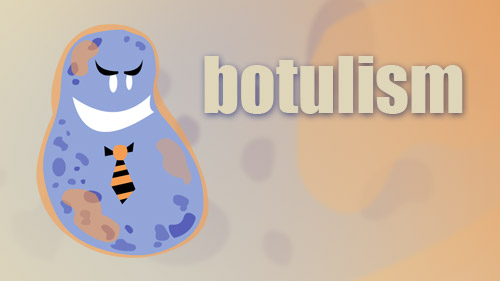If you read my Grinch compost posts, you discovered that my indoor anerobic compost experiment didn’t work out exactly as planned. It stank way more than I had been led to believe it would, so it went straight outside for long-term putrefaction far away from sensitive noses. While it was extremely easy to deal with that problem, far peskier was a question a friend posed about the risk of botulism in such compost.
I have been doing a good deal of reading on the subject and can’t say I reached a definitive conclusion. I will start by saying that I don’t think it’s a giant risk, simply because I’ve never heard of it occurring. Now most people don’t set out to make anaerobic compost, but even the Mini Farming Guide to Composting book I referenced, with a chapter on intentional anaerobic composting, mentions an E. coli hazard but nothing about C. botulinum. Let me share with you a a few of the key lines of thinking I discovered
and let you be the judge about whether you want to take a walk on the wild (aka anerobic) side of composting. Since I’m not writing a scientific paper here, I’m not going to be rigorous about citing my sources, but I will give general references to web sites and researchers, and you can follow those leads yourself.
First let’s have a few facts. Botulism refers to a potentially lethal toxicity caused by a neurotoxin released by the bacteria Clostridium botulinum. That little fella is an obligate anaerobe, meaning it needs oxygen-less environments to live and multiply, but in the presence of oxygen or the absence of nutrients, it can generate a kind of a bomb-shelter endospore state into which it can retreat and maintain dormancy for a long time. As a spore, it can wait out the tough weather until things get pleasant and anaerobic again. C. botulinum produces one of the most potent toxins known to humans (and some animals like horses and cows). The toxin acts on motor nerve endings, preventing the neurotransmitter acetylcholine from being released, thus preventing muscle function. If you get enough of the toxin in you, you eventually succumb to what’s called flaccid paralysis and stop breathing. If you get poisoned and receive treatment in time, you may not die but may still require months or years of respiratory therapy. The toxin is so powerful that estimates state one teaspoon of the stuff could kill 1.2 billion people. Obviously this is not something to be trifled with.
Botulism poisoning can occur in three major ways. It can happen from consuming improperly preserved food containing the toxin (my most common association with it prior to research), from contacting the toxin with an open wound (reportedly associated with using black tar heroin which requires subcutaneous injections), or from ingesting bacteria and not having proper intestinal flora to combat the bacteria’s growth (which is why one doesn’t feed honey to babies under one – honey harbors the spores and the young child’s internal menagerie isn’t well enough developed to outcompete the bacteria when it reawakens in the anaerobic human gut.)
Clostridium botulinum is ubiquitous in soil and marine sediments, and indeed not properly washing produce may be how it is introduced into canned products, though it then requires the proper no-oxygen, low-acid, low-salt, more-or-less ambient temperatures to go to work forming the toxin. Interestingly enough, the bacteria alone does not produce the toxin. It requires a virus or phage to infect it, and apparently the virus’s genetics carries the code for toxin formation. Thus it is possible to have bacteria without toxins. The Wikipedia entry on Botulism states that ” little is known about the natural factors that control phage infection and replication within the bacteria,” so it’s apparently an open question as to when and why this bacteria forms its poisonous by-product. If this bacterium is truly everywhere, as in all-over-the-earth-in-every-bit-of-soil everywhere, it’s a wonder we gardener types aren’t falling one after another. Perhaps the presence of the bacteria without the toxins is why farmers, gardeners and players in the dirt aren’t getting paralyzed all the time when they eat a carrot with a bit or dirt on it or such. That and our internal flora can easily “take” any C.b. that gets introduced into our guts. Thank God. Sometimes too much info can be a scary thing. But all that being the case, there still remains the issue of whether by anaerobically composting one is introducing a hazard.
There is a bit of a divided court on whether the botulism bacteria populates compost, aerobic or anaerobic. According to the Organic Gardening Guru web site, anaerobic compost quickly becomes quite acidic, with pH as low as 4, and the World Health Organization, in its Botulism Fact Sheet #270, states that C. botulinum will not grow in acidic conditions lower than 4.6 (but be warned: pre-formed toxins are not degraded by low pH). Plus the OGG web site recommends a period of aerobic processing at the end of the anaerobic period, which would, in effect, destroy any active C. botulinum that was present (but not the spores or the already-formed toxins). One European researcher, Helge Bohnel, seems especially concerned about the presence of botulism in commercially processed compost, and that means aerobic compost. Apparently all compost piles, unless they are constantly rotated, stirred, or otherwise aerated, go through some anaerobic moments, or at least portions of them do, and as I mentioned in a previous post, an ugly whiff or two from your pile means that at least some part of your aerobic composting efforts have gone awry. Bohnel’s claim appears to be that even commercial-style, municipal compost can harbor some anaerobic “safe zones” where the botulism bacteria persists. Bohnel cites a German study that says about 50% of plant-based municipal compost tested positive for C. botulinum. Also in a study done by him and others, he showed that the bacteria from botulism-spiked compost may persist in the soil for years and may move about (translocate). Without claiming any immediate health hazard, he as his associates wonder if there might be problems with contamination of water supply and other health issues caused by compost-supplied bands of roving botulism bacteria.
What do we know about the toxin? Well, besides being deadly poisonous in small quantities, it is destroyable through cooking. It is a protein, and it will denature, or come apart structurally, at 185 F. Authorities recommend boiling (212F at sea level) a suspected sample for 15 minutes to guarantee detoxification. It will also denature with exposure to sunlight. One source said prolonged exposure, another specified three hours. More research would be required to determine exactly what’s needed here. Finally, as it relates to the compost pile, the botulism toxin would be just another protein – a food source that other bacteria and fungi could break down into amino acids and consume. How long a particular sample of botulism toxin would persist in a compost pile is anybody’s guess, and as our German friend Bohnel suggests, once the stuff gets back into its anaerobic zone in the soil, other oxygen-loving microbes may not be able to follow and eat the toxic protein.
Alright, maybe I’ve opened a can of worms here (hopefully a properly canned can; otherwise we have a botulism risk), but I’m going to let all that rest and make a few recommendations regarding the anaerobic compost I am trialing. First, I am going to wear gloves when I open it. The discovery that the botulism bacteria and toxin can enter the blood stream through a wound was an eye-opening aspect of my research. I’ll probably pour out the liquid from my buckets onto an existing compost pile that I don’t plan to use for a while and then let the solid material dry out in the sun before using it. Second, if I do continue anaerobic composting I will probably not use the complete water covering method. Some sources I consulted recommend partially burying a bucket or pail and adding a few holes in the bottom to let excess fluid drain. A loose lid or cover prevents additional water from getting in and keeps vermin out, plus it prevents top-blowing accumulations of methane, which may be an additional hazard with tightly sealed systems (creating, potentially, a botu-bomb). Material is heaped into the bucket, and basically its own water content creates the anaerobic conditions under which it composts. The recommendation is to fill the bucket then leave it alone for a year, allowing aerobic microbes to re-inhabit the pile after the anaerobic phase is done.
Why not just have done with it all and give up anaerobic composting if there’s any risk at all? Well, the scientist-citizen part of me is intrigued. I don’t want to be scared away from a potentially valuable garden technique if there’s really nothing to be worried about. Plus my inner truth seeker says that with some more research and study it should be possible to determine whether or not there is a risk. Aerobic composting requires lots of work and often results in the loss of a great deal of the nutrients, especially the off-gassing of nitrogen as ammonia, so it may be worthwhile developing some skills and knowledge around anaerobic methods. Lastly, as anyone who’s heard about Botox knows, sometimes even a deadly substance, if managed correctly, brings benefits (though the benefits of Botox are highly suspect) to humans.
I don’t think I’m through with this yet, and, of course, I do have those two 5-gallon pails of anaerobic compost in the way back of my yard, just sitting and stinking as I await their late-summer opening. So more on this subject in 2014.

